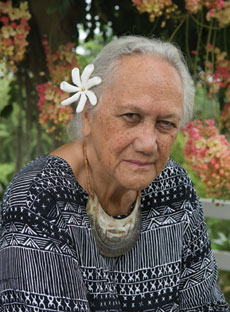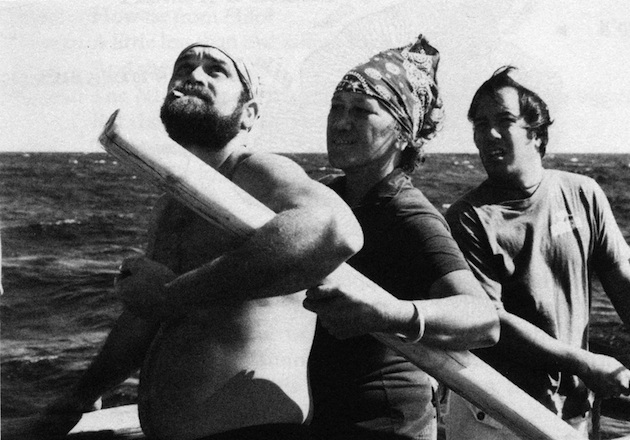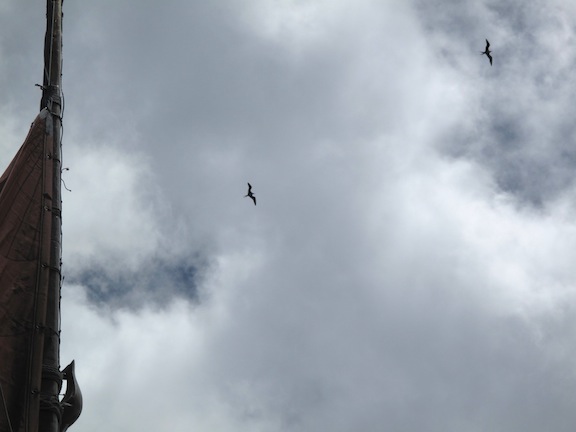Joanne Kahanamoku Sterling

Photo by Robbyn Peck, Honolulu Magazine, Nov. 2006
Master feather worker had vibrancy in life and her art
Lee Cataluna, Star Advertiser. POSTED: 01:30 a.m. HST, Jun 25, 2010
Jo-Ann Kamuela Kahanamoku-Sterling was the kind of lady who told you exactly what she thought but hinted that her best adventures were too good to share.
"I won't answer any questions about anything I did before I was 50!" she told me when I interviewed her in 2008. "I was naughty."
Kahanamoku-Sterling, 80, was an artist, a teacher, a Hokule'a crew member and a wonderful storyteller. She was the daughter of Samuel Alapai Kahanamoku, brother of Duke Kahanamoku, and carried that famous family name with great style. She died on June 11 in her Big Island home. Her ashes will be taken on a final journey on Hokule'a from Waikiki tomorrow.
She was a member of the Polynesian Voyaging Society for decades starting in the late '70s. She went on numerous voyages, including the 34-day sail from Hawaii to Tahiti in 1980. She thought it might have been her destiny to travel. She had a birthmark on her left leg, a sure sign, according to old Hawaiian beliefs, that she was always up to something, always going somewhere.
Kahanamoku-Sterling did her best to live up to that prediction. She grew up both in Hawaii and Tahiti, where her mother was born. She lived in New York for several years, worked in Los Angeles, lived on Maui, then Molokai and finally found the island of Hawaii was varied and changeable enough to suit her nature.
Her connection to Hokule'a is what brought her to feather work. The feather work, she said, is what brought her peace.
She started learning feather work in the 1980s and became one of the master feather workers of our time. Her capes and kahilis are in galleries and hotels around the islands. A 4-by-5-foot feather cape in blue, yellow and black is on display at the King Kamehameha Golf Club on Maui. To make such a large piece, each tiny feather was placed one at a time, a process that could take months of constant work. For an excitable person like Kahanamoku-Sterling, that intense focus and dedication was soothing.
Kahanamoku-Sterling liked to tell the story about that cape.
"A man asked me, 'How do you make this?' and I answered him, 'With glue!'"
She liked to surprise people that way. "It is an ancient art form, but I'm a contemporary artist," she said. Traditionally, the feathers were sewn on. Glue wasn't traditional, but neither was she.
For a time, Kahanamoku-Sterling taught feather-work classes to a group of senior citizens on Maui. One day she realized that none of her students had ever been to the Bishop Museum or Iolani Palace, so she told them, "OK, gang, we're all going to Honolulu!"
On the trip she was touched that her students wept seeing the museum and the palace for the first time, so she planned more trips, eventually taking the entire bunch to Tahiti. It was something none of them ever thought they'd do, but with Kahanamoku-Sterling leading the way, all sorts of adventures suddenly seemed possible.
Bishop Museum Celebrates Native Hawaiian Artists (2007)
Jo-Anne Kahanamoku-Sterling lives up to her Kahanamoku name – a waterwoman, she is one of the few longstanding female crewmembers of the Polynesian Voyaging Society. From 1977-1998, she participated in numerous sails, traveling throughout the Society Islands, Tonga, New Zealand, Rapa Nui, Samoa, the Cook Islands, and Hawaii.
But it is for her artistry in Hawaiian Feather Making that Kahanamoku-Sterling is being honored. For over a decade, her stunning feather capes and lei have appeared in shows and galleries on Maui , O’ahu and Hawai’i island. She is a dedicated teacher of the art of featherwork. “We are not interested in time when performing our featherwork. The traditional Hawaiian was free of time. Featherwork should be determined by how it begins, evolves, and ends; to allow the spirit and rhythm to dictate its course.”
A Tribute to Leon and Joanne, by Kaimana Barcuse and Kalepa Baybayan

Leon, Joanne, and Harry Ho, from Will Kyselka's An Ocean in Mind (1987)
Mai ka ulu koa o uka a i ka ulu koa o kai
Ua kani ka papa waʻa i ka hoʻi o ke alohaE kūnou nā kia me he niu moe
No Paoa lāua ʻo KahanamokuFrom the upland koa forest, to the koa forest on the sea
The core of the canoe has sounded at the departure of the loved onesLet the masts bow as the laid over niu tree
In honor of Paoa and Kahanamoku
A kanikau, chant of mourning composed by Kaimana Barcarse.
Jo-Anne Kamuela Kahanamoku and Leon Alfred Paoa Sterling were significant contributors to the revitalization of the modern day voyaging movement and its establishment as a dynamic part of Hawaii’s culture. The former husband and wife team passed away on the morning of June 11th.
The daughter of Sam Kahanamoku and the niece of the legendary Duke Kahanamoku, former Olympic Medalist both in swimming, Joanne possessed an inherited natural ability to perform well while being on the ocean. Kahanamoku was a former Polynesian Voyaging Society vice-president, serving in that capacity in the formative years of the organization. She was a crewmember on the 1980 voyage to Tahiti, 1986 voyage from Tonga to Samoa, and the 1995 voyage within the Society Islands.
Leon was the First Mate aboard Hokule’a on the 1978, 1980, and 1985 Voyage of Rediscovery. He served as Captain on the 1986 sail from New Zealand through Tonga and Samoa. He also participated on the West Coast voyage of Hokule’a from Seattle to Vancouver, British Columbia. He last sailed aboard Hokule’a in 1999 as the Watch Captain from Hilo to the Marquesas.
They came to voyaging as a couple in 1975, beginning with the Hui o Wa’a Kaulua aboard the Mo’olele, training off of West Maui and the waters between Moloka’i and Lana’i. In 1976, they sailed the Mo’olele to the Big Island, sailing and camping along the Kona coast. They eventually returned to the Big Island to reside in 1977 and when Hokule’a arrived in the spring, Leon filled in as captain on some of the training sails. Leon was aboard the 1978 trip in which Hokule’a capsized and he and Joanne were instrumental as a catalyst in the restoration of the canoe.
For those of us who knew them, their simultaneous passing in different locations remains an inexplicable mystery, something connected to the deed of a greater power. Nonetheless, there seems to be an appropriateness in the manner in which the passing of these two people, so intimately connected for much of their lives, unfolded.
In their life together and apart, they touched many hearts. Their legacy lives on in those of us who continue the daunting challenge of keeping fledgling voyaging programs afloat in the most challenging of times.
E kuhi ka ihu I ka ‘ale kualoloa.
Keep the bows pointed toward the broad back swells of the open ocean.
Kaimana captured this picture of two 'iwa (frigate birds) circling above Hokule'a as she sailed back to METC after scattering Joanne's ashes.

Excerpts from a report in the Maui News, by Kekoa Enomoto. POSTED: June 13, 2010
Jo-Ann Kahanamoku, of Kailua-Kona, and formerly of Maui - who was a grandniece of late surfing icon and Olympian Duke Paoa Kahanamoku, and was known statewide for her exquisite feather art - died in Kailua-Kona. She was 80.
Jo-Ann Kamuela Kahanamoku was born in 1929 in Papeete, Tahiti. A former artist-in-residence at Maui Community College, she was the recipient of the Duke's Waikiki 2008 Ho'okahiko Award and of the 2005 Maoli Arts Month Festival's lifetime achievement award for contributions to Hawaiian visual arts. She also served as curator of Kealakowa'a heiau for the Kona Outdoor Circle; as cultural adviser to the Kona Hospital Foundation, and on the Native Hawaiian Historic Preservation Council of the state Office of Hawaiian Affairs.
Featherwork teacher Paulette Kahalepuna, owner of Na Lima Mili Hulu No'eau shop in Kapahulu, Oahu, said Kahanamoku created and worked "with a lot of authority."
"As a seafarer, she paid a lot of respect to the feathers from those frigate birds they would see out at sea or as they came into land. She was very mindful of those feathered elements. To be able to use them as elements of her art was tremendous and speaks well of her," Kahalepuna said.
